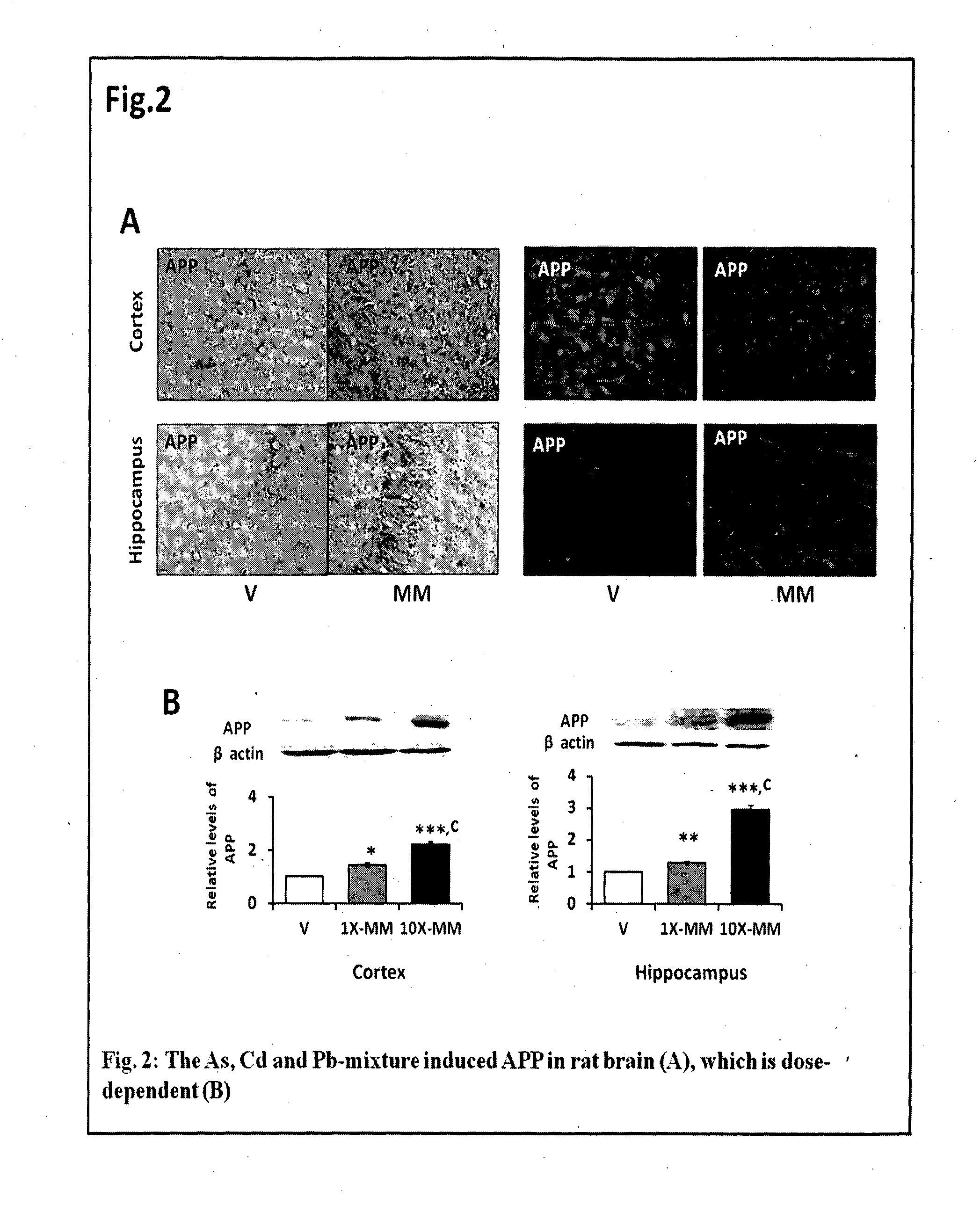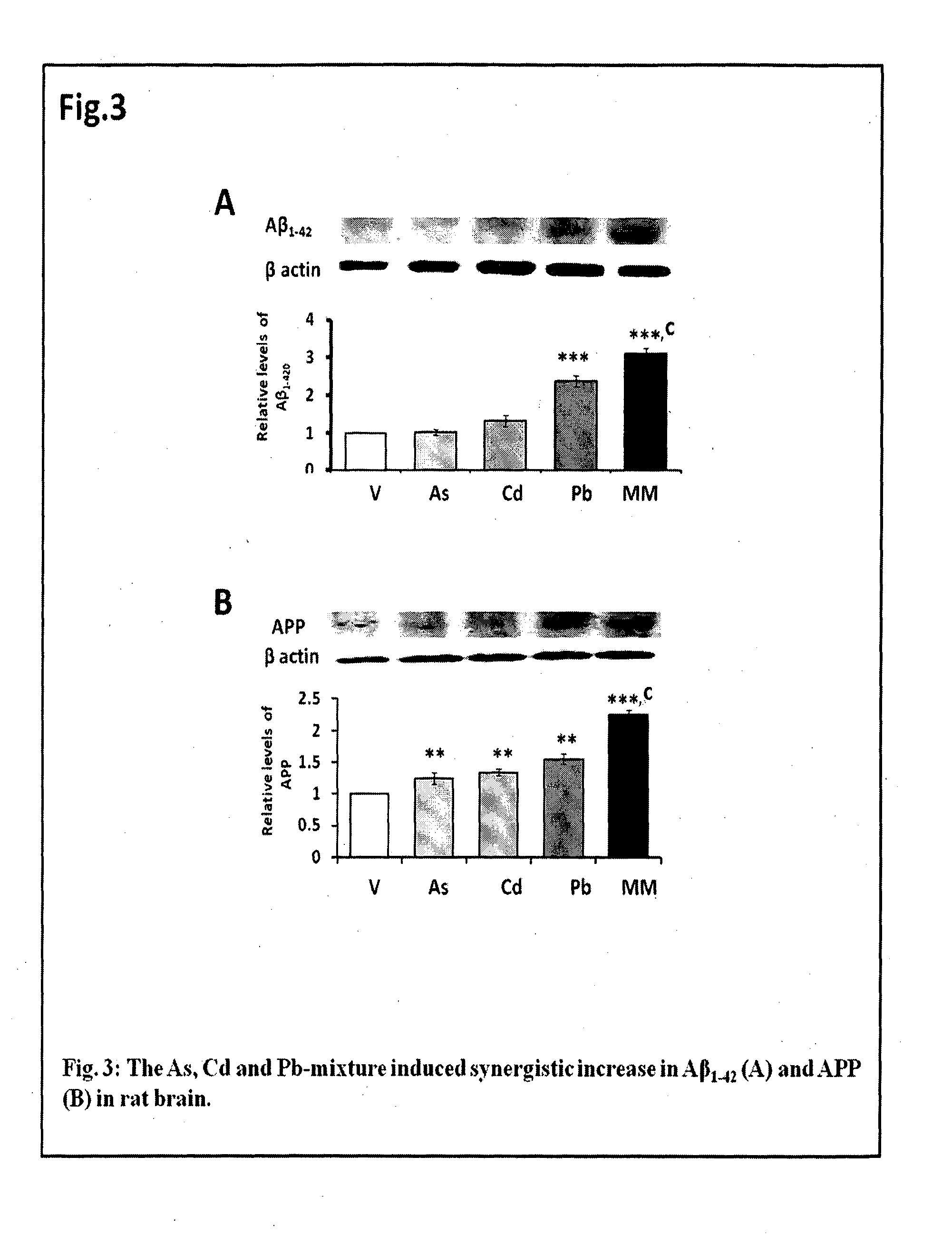Model of alzheimer's disease
a wistar rat and model technology, applied in the field of non-transgenic animal wistar rat models, can solve the problems of inducing dementia, affecting cognition, affecting cognition, etc., and achieves the effects of reducing the risk of ad, and suppressing the levels of a and app
- Summary
- Abstract
- Description
- Claims
- Application Information
AI Technical Summary
Benefits of technology
Problems solved by technology
Method used
Image
Examples
example 1
Treatment of as, Cd and Pb for the Development of Early Wistar Rat Model of AD
[0080]All animal-handling procedures were carried out in accordance with the current regulations of the Indian Institute of Toxicology Research Animal Ethics Committee, and with its prior approval for using the animals. The pregnant female wistar rats were housed in a 12-h day and light cycle environment with ad libitum diet and water. The rats were divided into six groups (n=30 per group), gavage-treated with the metal mixture (Table 1). The metal mixture treatment was at two concentrations (1× and 10×; Groups 1-3, Table 1) for dose-dependent study. To identify the synergistic nature, the animals were treated in mixture as well as individually with the metals (Group 1-6 of Table 1). The heavy metals were As, Cd and Pb, fed in the form of NaAsO2, CdCl2 and Pb(C2H3O2)2, respectively, in Milli Q water. The NaAsO2, and CdCl2 readily dissolved in water, while Pb(C2H3O2)2 was dissolved by adding 0.043% acetic a...
example 2
Determination of the Levels of APP, Aβ, APP-CTF-β, Presenilin, IL-1α, IL-1β, IL-1R1, RAGE and pGP in the Hippocampus and Cortex Through Western Blotting
[0083]Tissues of the cerebral cortex and hippocampus from five to seven postnatal wistar rats were harvested, snap-frozen in liquid nitrogen, and stored at −80° C. until further investigation. SDS-PAGE and western blotting was performed with APP (1:1000), Aβ-40 (1:1000), Aβ-42 (1:1000), APP-CTF-β (1:1000), presenilin (1:1000), IL-1α (1:1000), IL-1β (1:1000) and IL-1R1 (1:1000), RAGE (1:1000) and pGP (1:1000). The working dilutions for secondary anti-rabbit IgG and anti-mouse IgG conjugated to horseradish peroxidase were 1:2000 in 0.2% Triton X-100 containing PBS. The samples were detected by chemiluminescence with super signal west femto max substrate. Relative expression of each protein was determined by densitometric quantification of blots using VersaDoc Gel Imaging System (BioRad, Hercules, CF).
example 3
Determination of the Expression of APP, Aβ and Iba-1 in the Hippocampus and Cortex Through Immunostaining
[0084]Four wistar rat pups from four separate litters, treated with the metal mixture or vehicle, were anaesthetized and perfused, and the cerebral cortex and hippocampus were fixed and cryoprotected. Briefly, five to 10-μM cryostat sections were made using cryomicrotome (Microm HM 520, Labcon, Germany), and mounted on (3-Aminopropyl)triethoxy-silane coated slides. For immunofluorescence, a standard immunofluorescence technique was used. The sections were blocked in 10% normal donkey serum / 0.1M PBS and then incubated with the antibodies (1:100) at 4° C. for overnight. For detecting the expression of APP, Aβ or Iba-1, the sections were immunostained with monoclonal APP, Aβ or Iba-1 antibodies. Following a rinse in 0.1M PBS, the sections were incubated with Alexa Fluor 546 goat anti-rabbit IgG conjugate (1:200) and Alexa Fluor 488 goat anti-mouse IgG conjugate (1:200) for 60 min. A...
PUM
 Login to View More
Login to View More Abstract
Description
Claims
Application Information
 Login to View More
Login to View More - R&D
- Intellectual Property
- Life Sciences
- Materials
- Tech Scout
- Unparalleled Data Quality
- Higher Quality Content
- 60% Fewer Hallucinations
Browse by: Latest US Patents, China's latest patents, Technical Efficacy Thesaurus, Application Domain, Technology Topic, Popular Technical Reports.
© 2025 PatSnap. All rights reserved.Legal|Privacy policy|Modern Slavery Act Transparency Statement|Sitemap|About US| Contact US: help@patsnap.com



